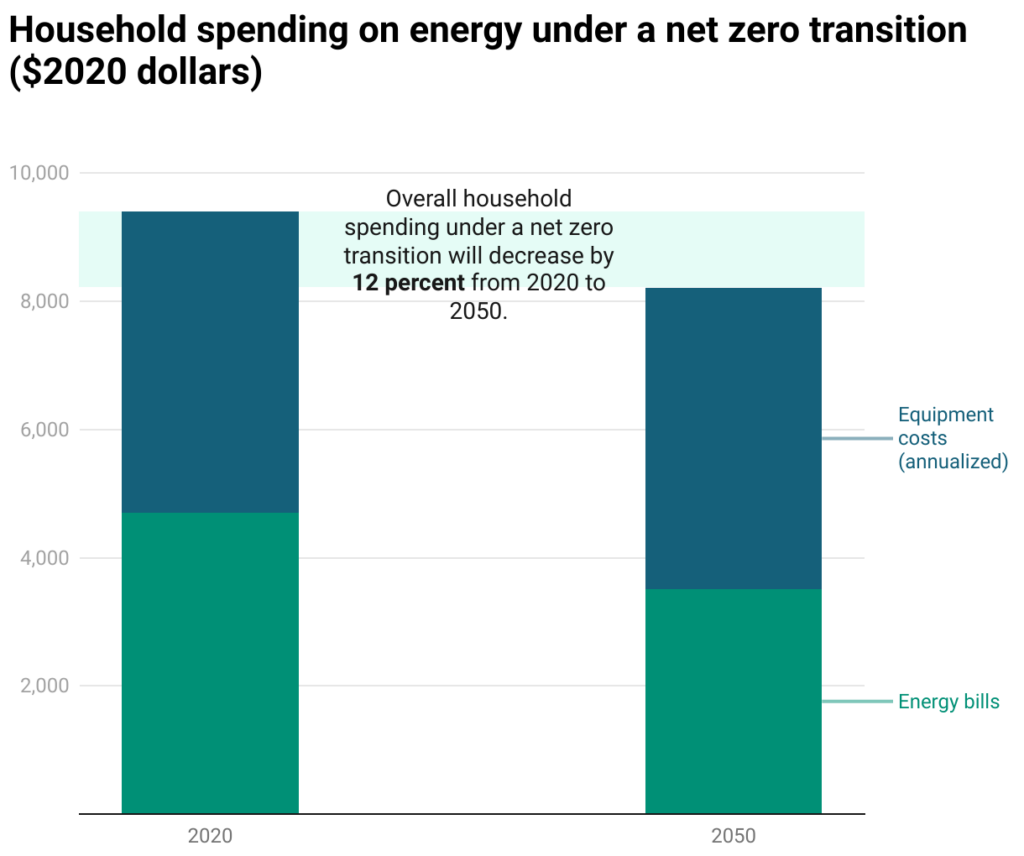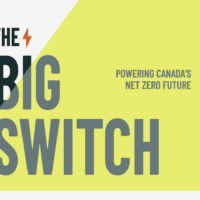This article was previously published in Corporate Knights.
Climate change and affordability are closely intertwined. The effects of the climate crisis already cost Canadians an average of $720 per year in repairs after flooding or wildfires—and that price tag is expected to double or triple by 2050.
Reducing greenhouse gas emissions can help mitigate these impacts and their costs. The Canadian Climate Institute has explored in detail Canada’s options for getting to “net zero” emissions. There’s little debate that the big switch from fossil fuels to clean electricity will be a cornerstone of Canada’s net zero future and a competitive necessity for the economy.
But our latest analysis turns up another important benefit: this switch will see Canadian households spending less on energy compared to today.
Notably, our most recent calculations find that, on average, energy costs for Canadians will decline around 12 per cent by 2050 (Canada’s target year for reaching net zero)—even with the investments required for household equipment, such as heat pumps, and electricity grid expansion. And that’s before factoring in the policies already in place to make the transition more affordable for households (things like rebates for electric vehicle, home retrofit rebates or carbon pricing). While this finding may be a surprise for some, recent polling shows that 2 out of 3 Canadians already know it.

Consider how much you spend each year refuelling your vehicle. An average Canadian driving around 15,000 km will pay about $2000 a year for gas (ignoring recent price spikes seen in 2022) but could refuel an electric vehicle for $350 a year for the same mileage. Electric motors are more than twice as efficient as combustion engines at converting energy to motion. Even if average electricity rates increase as we build out power grids to meet growing demand, the total cost of owning and operating an electric vehicle (EV) still offers net savings. Consumers are catching on — roughly 1 in 10 cars sold in Canada last year was electric. While EVs still come with a price premium up front, the costs of their batteries have fallen by over 90 per cent since 2010. As their market share increases, economies of scale and experience will further drive down their costs. Some expect them to reach price parity within five years without subsidies.
Similarly, heat pumps (which can be used to heat and cool homes, and are typically three times more efficient than baseboard heating or gas furnaces) offer payback for consumers. But help with the equipment cost will remain important for access, even as costs fall. Financing, including low-interest loans, can help households afford the upfront cost and shorten the payback period (supports are already available but can be overly complex).
Affordability isn’t just about average costs; it’s also about stability. Fossil fuel prices are much more volatile. Russia’s invasion of Ukraine led to record-high spikes in gasoline and natural gas prices and these spikes pose challenges for household cash flows. Switching to electric vehicles and heating can buffer Canadians from having to make sudden and difficult budget choices because of global events.
The data backs this up: Multiple U.S. studies show prices for electricity are more stable and predictable relative to gasoline and natural gas for domestic consumption, even preceding the Ukraine crisis. And according to the International Energy Agency, a net zero pathway not only lowers energy bills, but also protects households from global energy price shocks, reducing energy costs by 40 per cent during such times relative to the status quo.
Of course, a widespread switch to electricity still presents challenges. Low-income households and renters may not be able to unlock the benefits of electrifying. While renters pay energy bills, landlords choose heating systems. Low-income households are likely to be some of the last to switch from fossil fuels, and the costs of maintaining fossil energy systems risk falling disproportionately on them. Careful policy-making can and should ensure that all Canadians are able to enjoy the benefits electrification can offer. For example, technology rebates can be higher for low-income households, and avoid their having to bear costs up-front. Regulations and incentives can ensure tenants get to benefit.
Done right, the energy transition won’t just be good for the climate or the economy, but also for our bank accounts.








